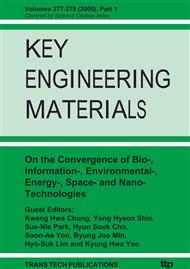p.62
p.67
p.72
p.77
p.82
p.90
p.96
p.102
p.107
Preparation and Properties of Crosslinked Polyurethane Containing Hydrophilic PEO Component for Biomaterials
Abstract:
A series of multiblock polyurethanes containing various poly(ethylene oxide) (PEO) contents (0-80 wt%) were prepared from hexamethylene diisocyanate (HDI)/ PEO / poly(tetramethylene oxide) (PTMO)/ polybutadiene diol (PBD)/ 1,4-butanediol (BD) and used as modifying additives (30 wt%) to improve the properties of biomedical grade PelletheneÒ. A hydrophilic PEO component was introduced by the addition of PEO-containing polyurethanes and dicumyl peroxide (DCP) as the crosslinking agents in a PelletheneÒ matrix. As the PEO content (PEO block length) increased, the hydrogen-bonding fraction of the crosslinked polyurethane also increased, indicating an increase in the phase separation with an increase in the PEO content in the crosslinked polyurethane. Using electron spectroscopy for a chemical analysis, the ratio of ether carbon to alkyl carbon in the crosslinked polyurethane film increased remarkably with an increase, in the PEO content. Meanwhile, the water contact angle of the crosslinked polyurethane film surfaces decreased with increasing PEO content. The water absorption and mechanical properties of the crosslinked polyurethane films increased with increasing and the platelet adhesion on the crosslinked polyurethane film surfaces decreased significantly. Accordingly, these results suggest that the crosslinked polyurethane containing a hydrophilic PEO component may be more effective for a biomaterial application that is in direct contact with blood.
Info:
Periodical:
Pages:
82-89
Citation:
Online since:
January 2005
Authors:
Keywords:
Price:
Сopyright:
© 2005 Trans Tech Publications Ltd. All Rights Reserved
Share:
Citation:


